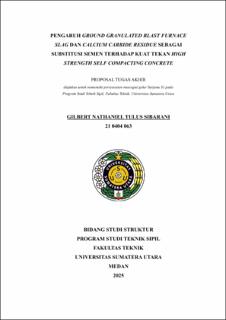| dc.description.abstract | The advancement of concrete technology demands sustainable material innovations, one of which is the application of High-Strength Self-Compacting Concrete (HSSCC) using Ordinary Portland Cement (OPC). However, the use of OPC in high-strength concrete results in significant CO₂ emissions and requires a low water-cement ratio, which reduces workability. This study utilizes Ground Granulated Blast Furnace Slag (GGBFS) and Calcium Carbide Residue (CCR) as partial cement substitutes to mitigate environmental impact while maintaining concrete performance. In this study, GGBFS was used with variations of 0%, 10%, 20%, 30%, 40%, and 50%, while maintaining a constant CCR of 10% as a substitute for cement. Cylindrical specimens (10 cm diameter × 20 cm height, n = 3 per mix) were prepared. Fresh concrete tests included T₅₀, slump flow, L-Box, and V-Funnel, while hardened concrete was evaluated for compressive strength at 28 days. The use of TamCem Normet 60RA superplasticizer at 1.8% of cement weight effectively maintained SCC characteristics. Fresh concrete test results indicated that all mixtures showed reduced workability compared to conventional concrete but still met EFNARC 2005 criteria for SCC. The incorporation of GGBFS and CCR enhanced compressive strength across all variations, with the optimum mix (40% GGBFS + 10% CCR) achieving 78.28 MPa. This study demonstrates that HSSCC performance can be preserved with up to 50% GGBFS and 10% CCR, offering an eco-friendly concrete solution without compromising strength or workability. | en_US |


